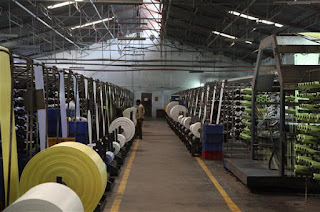TROUBLESHOOTING EXTRUSION COATING
| ADHESION | APPLESAUCE | DRAW RESONANCE |
| EDGE TEAR | GAUGE BANDS | GELS |
| MOLTEN CURTAIN BREAKS | ODOR | OXIDATION |
| HEAT SEALABILITY | SURGING | VOIDS |
| Problem | CAUSE (REASON) | SUGGESTED CORRECTIONS |
| ADHESION | A Melt temperature too low (polymer viscosity too high) | 1 Increase temp. settings. 2 Check for heater and/or controller malfunctions. 3 Increase back pressure. |
| B Melt temp. too high (polymer viscosity too high or polymer thermally degraded | 1 Decrease temp. settings. 2 Check for heater/controller malfunctions. 3 Decrease back pressure. | |
| C Inadequate oxidation | 1 Increase air gap. 2 Lower line speed. 3 Increase flame or corona treatment. | |
| D Premature cooling | 1 Decrease air gap. 2 Increase chill roll temp. | |
| E Chill roll tack | 1 Decrease chill roll temp. | |
| F Non-optimum substrate surface | 1 Pre-treat substrate. 2 Change substrate. | |
| G Additive effects | 1 Confirm that proper type and level of additive are used. | |
| APPLESAUCE | A Resin incompatibility | 1 Check on resin compatibility (chemical and rheological). 2 Make sure previous resin is completely purged. |
| B Temperature too high (degradation | 1 Decrease temperature. | |
| C Temperature too low (increased viscosity) | ||
| DRAW RESONANCE | A Draw ratio too high | 1 (See Edge Tear). |
| B Temperature too high | 1 Decrease polymer temp. 2 Repair runaway heaters. | |
| EDGE TEAR | A Draw ratio too high | 1 Decrease die gap. 2 Increase coating weight |
| B Die end temperature too low | 1 Increase temperature of die ends. | |
| C Incorrect polymer temp. | 1 Adjust temp. to optimum. | |
| GAUGE BANDS | A Unclean die | 1 Clean die interior periodically. 2 Scrape the inside of die lips to dislodge foreign material. |
| B Improperly adjusted die | 1 Adjust die bolts 2 Measure die gap periodically. | |
| C Temperature variations | 1 Repair heater malfunctions. 2 Keep adapter, transfer pipe, and die temps. close to the extruder melt temp. | |
| D Temperature too high | 1 Lower temp. settings. 2 Repair malfunctioning heaters or controllers. | |
| GELS | A Resin contamination | 1 Keep extruder and storage areas clean |
| B Incorrect melt temp. | 1 Adjust to optimum. | |
| C Poor purging | 1 Use proper purging techniques. | |
| D Poor mixing | 1 Increase back pressure 2 Increase number or density of screen packs. 3 Assure compatibility of blends. | |
| MOLTEN CURTAIN BREAKS | A Draw ratio too high | 1 Decrease die gap. 2 Increase coating weight. |
| B Incorrect melt temp. | 1 Adjust to optimum. | |
| ODOR | A Over-Oxidation | 1 Decrease melt temp. 2 Decrease air gap. |
| OXIDATION | A Degradation | 1 Decrease temperature. 2 Increase screw speed. 3 Clean non-streamlined areas often. |
| B Poor purging | 1 Use proper techniques, usually lower temp. 2 Do not stop extruder when still above 400 F. 3 Always purge out copolymer with a homopolymer before turning off extruder. | |
| HEAT SEALABILITY | A Over-oxidation | 1 Decrease melt temperature. 2 Decrease air gap. 3 Check corona treatment. |
| B Contamination | 1 Check on additives used. 2 Keep handling of sealant surface to minimum and keep stock in clean dry area. | |
| SURGING | A Hopper bridging (improper feeding) | 1 Reduce feed zone temp |
| B Improper screw design | 1 Use appropriately designed screw for the resin(s) employed. | |
| VOIDS | A Moisture | 1 Avoid abrupt temperature changes in product storage. 2 Check for leaks in resin handling system. 3 Protect hygroscopic resins from humidity. 4 Condensate in feed throat |
| B Polymer degradation | 1 Do not exceed recommended maximum melt temperatures. 2 Oxidation | |
| C Gels |



Comments
Post a Comment